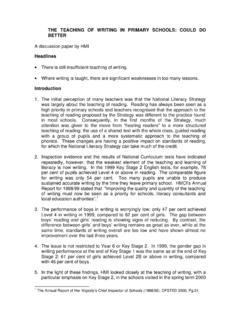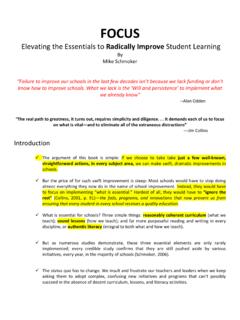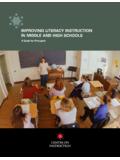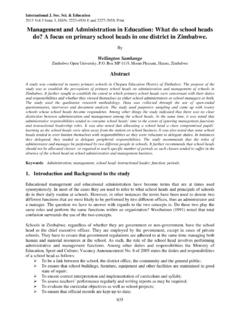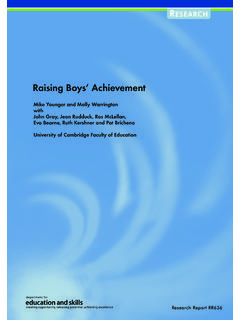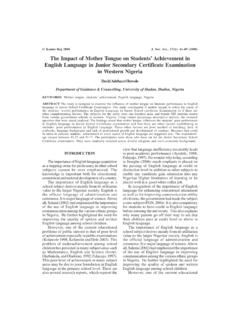Transcription of Kenya National Survey for Persons with Disabilities
1 Kenya NationalSurvey for Personswith DisabilitiesPreliminary ReportiPreliminary ReportMarch 2008 Kenya NationalSurvey for Personswith DisabilitiesPreliminary ReportiiKenya National Survey for Persons with DisabilitiesAny part of this document may be freely reviewed, quoted, reproduced or translated in full or in part,provided the source is acknowledged. It may not be sold or used in conjunction with commercial purposesor for National Survey for Persons with Disabilities Preliminary ReportPublished by: National Coordinating Agency for Population and DevelopmentPO Box 48994 - GPO, Nairobi 00100, KenyaTel: 254-20-271-1600/01 Fax: ReportContentsLists of Tables and FiguresivList of AbbreviationsvAcknowledgementsviiExecuti ve Objectives and Instruments and for the Training of the Processing and Rate of Devices and Support of of Immediate , Income and Social and General of Reproductive Health towards Persons With Next Steps20 Glossary21ivKenya National Survey for Persons with DisabilitiesLists of Tables and FiguresList of Tables1:Response rates for household and individualinterviews62.
2 Number and percentage distribution ofrespondents by background characteristics73:Prevalence of Disabilities by backgroundcharacteristics84:Distribution of PWDs by sex and by type ofdisability95:Number and percentage of PWDs usingassistive devices/support services bybackground characteristics96:Situation of PWDs without use of assistivedevices by background characteristics117:Percentage of PWDs by activity limitationand background characteristics Going toschool128:Effect of immediate surroundings bybackground characteristics139:Effect of environmental factors on PWDs bybackground characteristics1410: Activities undertaken by respondents in thelast seven days by background characteristics1511:Type of grant currently received bybackground characteristics1612:Percentage of PWDs who are aware of andhave ever needed or received health servicesby background characteristics1713:Percentage distribution of women withdisabilities age 12 49 who are currently usingfamily planning by method and backgroundcharacteristics1814:Attitudes towards PWDs by backgroundcharacteristics (by percentage)19 List of Figures1:Prevalence of Disabilities by type82:Distribution of PWDs by perception ofdisability as it is without use of assistivedevices by residence103:Distribution of PWDs by residence and typeof grant received164:Distribution of PWDs by sex and type ofgrant received165:Proportion of women PWDs aged 12 49years by residence and type of familyplanning method used186.
3 Distribution of PWDs by sex and how oftenpeople s attitudes have been a problem athome19vPreliminary ReportList of AbbreviationsADLA ctivities of daily livingAPDKA ssociation for the Physically Disabledof KenyaDFIDD epartment for InternationalDevelopmentIDPI nternational Development ProjectKNBSK enya National Bureau of StatisticsKNSPWDK enya National Survey for Personswith DisabilitiesKPDPK enya Programme of Disabled PersonsMGSCSSM inistry of Gender, Sports, Culture andSocial ServicesMOESTM inistry of Education, Science andTechnologyMOHM inistry of HealthNASSEPN ational Sample Survey andEvaluation ProgrammeNCAPDN ational Coordinating Agency forPopulation and DevelopmentPWDsPersons with disabilitiesSPSSS tatistical Package for Social StudiesSTATCAPS tatistical Capacity Building ProjectTOTT raining of trainersUDPKU nited Disabled Persons of KenyaviKenya National Survey for Persons with DisabilitiesviiPreliminary ReportAcknowledgementsThe 2007 Kenya National Survey forPersons with Disabilities (KNSPWD) aimedat getting up-to-date information onpersons with disability for purposes ofplanning, monitoring and evaluation Survey specifically estimated the numberof PWDs, their distribution in the country, thenature, types and causes of their Disabilities , theproblems they face, and the coping mechanismsthey use.
4 The Survey interviewed PWDs of all agesin sampled areas to get these estimates and soughttheir knowledge of available services and theirperceptions of community members attitudestowards PWDs as well as the attitudes ofcommunity members Ministry of Planning and NationalDevelopment, through the National CoordinatingAgency for Population and Development(NCAPD) and the Kenya National Bureau ofStatistics (KNBS), wishes to acknowledge theKNSPWD Steering Committee for its effectivepolicy guidance and oversight of the Survey . Wethank as well the KNSPWD Technical Committeemembers for their valuable technical input in theplanning and development of the surveyinstruments used in the collection of information, inaddition to facilitating data collection and analysisand the writing of this thanks go to the Regional PopulationCoordinators, District Statistical Officers andthe Division of Child Health for coordinatingall the activities that led to the successfulimplementation of the Survey .
5 In particular, weexpress our gratitude for the work done by theinterviewers and drivers who collected want to mention in a special way all therespondents countrywide who provided theinformation needed to accomplish the objectives ofthis Survey . Without their cooperation, the surveywould not have been sincerely appreciate the financial andtechnical support given by theDepartment for InternationalDevelopment (DFID), the World Bank, the UnitedStates Agency for International Development(USAID) and the United Nations Population Fund(UNFPA).Dr. Boniface K OyuigiChief Executive OfficerNational Coordinating Agency for Population andDevelopmentviiiKenya National Survey for Persons with DisabilitiesixPreliminary ReportOver the years, there have beenunsuccessful attempts in Kenya todetermine the disability status throughnational censuses and studies by civilsocieties, non-government organizations andgovernment.
6 Lack of evidence-based data on thenature and extent of Disabilities as well as otherfactors that affect Persons with Disabilities (PWDs)in Kenya has therefore posed challenges in terms Kenya National Survey for Persons withDisabilities (KNSPWD) was designed to provideup-to-date information for planning, monitoringand evaluating the various activities, programmesand projects geared towards improving thewellbeing of CollectionThe information collected included an estimationof the number of PWDs; their distribution,demographic, socio-economic and culturalcharacteristics; the nature, types and causes ofdisabilities; coping mechanisms; and the nature ofservices available to preliminary report presents key findings ofthe household-based interviews conducted duringthe Survey . The household Survey utilized a two-stage cluster sampling design.
7 Out of the 1,800clusters maintained by the KNBS, 600 clusters wereselected; of these 436 were rural and 164 wereurban. A systematic random sample of 25households per cluster was selected, resulting in asample size of 15,000 households. Successfulinterviews were conducted with 97% of thesampled households, while 96% of PWDs SummaryKey Findings The most common forms of Disabilities in Kenyaare associated with chronic respiratory diseases,cancer, diabetes, malnutrition, HIV/AIDS, otherinfectious diseases, and injuries such as thosefrom road accidents, falls, land mines andviolence. Six functional classifications of Disabilities wereused to compute the prevalence rate ofdisability. The question to the respondentsfocused on the individual s experience with orwithout use of assistive devices or supportservices. The overall disability rate was , nine in ten PWDs found disabilitywithout assistive devices a big problem.
8 Activity limitation refers to difficultiesexperienced by an individual in the absence ofany kind of assistance. The data indicate thatKNSPWD found that of Kenyans experience some formof disability. More disabled Persons reside in ruralthan in urban areas. 15% of PWDs are likely to be affected byenvironmental factors on a daily basisand 3% on a weekly basis. 65% of PWDs regard the environment asmajor problem in their daily lives. A quarter of PWDs work in familybusinesses, but a third do not work at all. 16% women with disability aged 12 49years use some form of family National Survey for Persons with DisabilitiesPWDs who are unable to carry out their dailyactivities were more likely to be residing in ruralareas (9%) than in urban areas (4%). The accessibility of the immediate surroundingsplays an important role in PWDs participationin various activities.
9 The Survey shows thatabout 15% of PWDs are likely to be affected byenvironmental factors on a daily basis and 3%on a weekly basis. Three out of five (65%) PWDsmentioned the environment as major problemin their daily lives. A third of the PWDs worked on own familybusiness with a quarter doing no work. About16% worked for pay and one out of tenindicated that they were homemakers. Thesurvey found that a third of PWDs use anassistive device or support service. Out of thisproportion, one in five uses an informationdevice while 12% use a personal mobility device. Overall, nine in ten PWDs are aware of thehealth care services available, but more PWDsin urban areas (95%) were likely to be aware ofhealth services than their rural counterparts(86%). However, PWDs residing in the urbanareas are less likely to have needed healthservices (72%), compared with their ruralcounterparts (79%).
10 Use of family planning wasfound to be 16% for female PWDs aged 12 to more detailed information will beavailable in the main report of the KNSPWD, thispreliminary report provides a sound basis for policymakers and programme managers to use insetting OrganizationsThe KNSPWD was undertaken by the NationalCoordinating Agency for Population andDevelopment (NCAPD) in collaboration with theKenya National Bureau of Statistics (KNBS), theMinistry of Health, Ministry of Education, Ministryof Gender, Culture and Social Services, and anarray of organizations for or of Persons withdisabilities. Technical and financial support for thesurvey came from the Department forInternational Development (DFID), the WorldBank and the United States Agency forInternational Development (USAID) under theSTATCAP project. The United Nations PopulationFund (UNFPA) provided support for the design ofthe Survey displayed by the people aroundthem can be a bigger problem for PWDsthan the medical condition they must copewith: People living and interacting withPWDs tend to treat them differently inrelation to their Bureau of StatisticsMinistry of Planning and Coordinating Agency forPopulation and Development(NCAPD)PO Box 48994 - GPON airobi 00100.
